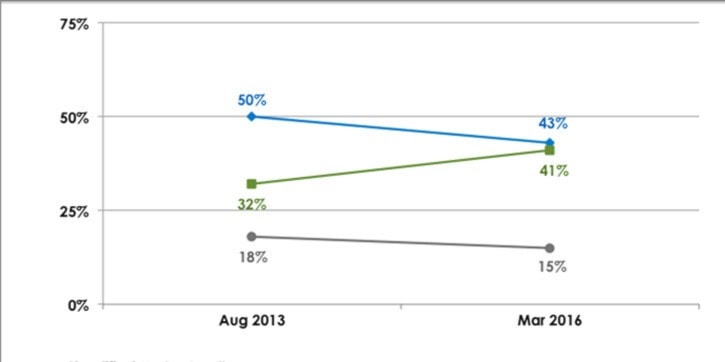According to a new Insights West poll, support for the province's liquefied natural gas (LNG) push has dropped, while negative concerns over hydraulic fracturing (fracking) have increased.
According to the poll, support for the province's intention to expand the development and export of LNG dropped from 50 per cent in August 2013 to 43 per cent in March 2016, while opposition to LNG grew from 32 per cent in 2013 to 41 per cent in 2016.
Mario Canseco, Vice President of Public Affairs at Insights West, says the drop in support for LNG expansion is accompanied by hardened views on fracking - the procedure by which oil and gas companies inject water and chemicals into the ground to fracture underlying shale rock formations and extract natural gas.
“The public’s distaste towards fracking is playing a role in perceptions of the provincial government’s actions on the LNG file,” says Canseco. “However, fewer British Columbians in 2016 believe that the LNG industry will be auspicious for every resident of the province.”
According to the poll, only 15 per cent of British Columbians think LNG will bring significant benefits to all B.C. residents, while 42 per cent believe it will exclusively benefit some communities. Almost three in 10 British Columbians (28 per cent) say LNG will not bring benefits to most B.C. residents.
When it comes to fracking, opposition has increased 14 per cent since the August 2013 poll. According to the latest poll, 23 per cent of respondents said they support it while 61 per cent said they were opposed.
Results are based on an online study conducted from March 16 to March 18, 2016, among 802 adult residents of British Columbia. The margin of error is plus or minus 3.5 percentage points.
The province's LNG projects face significant challenges. A glut of natural gas across North America has brought drilling activity in Northeastern B.C. gas fields to a near-halt. Challenges also include a reduction in global demand, regulatory uncertainty and the need to reduce capital spending because oil prices have plummeted.
Coastal GasLink Pipeline, which proposes to construct a 670-km natural gas pipeline from Northern B.C. to the proposed LNG Canada export facility near Kitimat, has signed 11 project agreements with First Nations groups to date, including the Burns Lake Band and Wet'suwet'en First Nation.
The pipeline proponent says the proposed project will create over 2000 jobs during construction and generate over $20 million in annual property tax payments. However, the Regional District of Bulkley-Nechako (RDBN) announced last year it was taking a careful approach to LNG development in the region.
In a press release, the RDBN said LNG development in the region has the potential to “negatively impact local communities” and place a burden on local infrastructure and services.
There are currently 20 proposed LNG projects in B.C. The provincial government set a goal of having three LNG facilities in operation by 2020.
Shell Canada announced in February it was postponing a final decision on the $50-billion LNG Canada project in Kitimat.
Delays also took place with Petronas-led Pacific NorthWest LNG project at Prince Rupert. The B.C. government recently sent officials to Ottawa to help work through the latest delay in the project.
